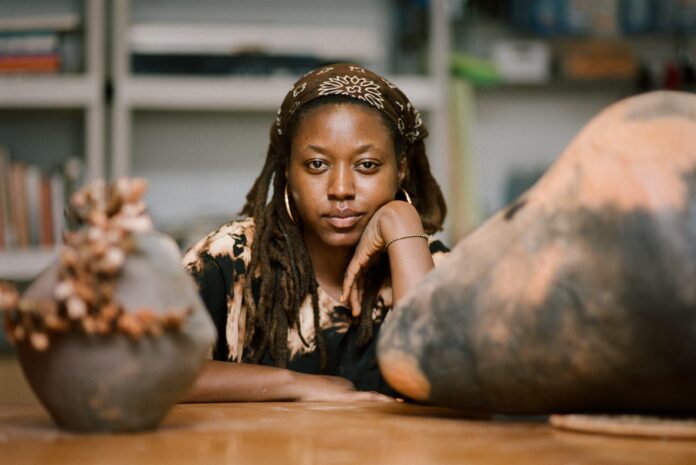The artist Adebunmi Gbadebo had never made clay work before her show at the Metropolitan Museum of Art. Before being selected to exhibit alongside the likes of Simone Leigh and Theaster Gates, Gbadebo was primarily focused on paper, realising works based on her research at True Blue Plantation on Pawleys Island, South Carolina.
Until 2020, Gbadebo—who is of both Nigerian and Black American descent—had never visited the plantation. That changed when the artist’s mother died from Covid-19. That year, Gbadebo travelled to the plantation—surrounded by cotton fields still owned by descendants of the original slave-owning family—to bury her mother’s ashes in the place where so many of the artist’s ancestors had been enslaved and eventually laid to rest.

Adebunmi Gbadebo’s In Memory of June Miller, 1871-1928, Gone but Not Forgotten, H.F.S. (2023) Clay and bones from True Blue Plantation Cemetery, Fort Motte, SC, gas firedH 12 X W 16 inches
Image courtesy the artist and Maximillian William, London. Photography: Deniz Guzel
“There was a burial ground established in the 17th century for enslaved people, and after emancipation our family still continued to be buried there,” she tells The Art Newspaper. “Our relationship with the space was never really severed.”
It is from this land, quite literally, that Gbadebo’s clay pots are derived—in a process she describes both physically and spiritually as an “excavation”. The two pots currently on view at the Museum of Fine Arts Boston as part of the travelling exhibition that was previously at the Met, Hear Me Now (until 9 July), and two new works showing in London at the artist’s first international gallery show at Maximillian William are made from plantation soil. Some include the strain of Carolina Gold rice developed on the plantation and others include (animal) bones from the site.

Adebunmi Gbadebo’s In Memory of Carrie Dash, 1903-1930, Here I Lay My Burden Down, B.A.S. (2023) Clay from True Blue Plantation Cemetery, Fort Motte, SC, Carolina Gold rice, pit fired H 13 x L 21 inches
Image courtesy the artist and Maximillian William, London. Photography: Deniz Guzel
Opening today (29 June), the London show—Inventing the Rest: New Adventures in Clay (until 12 August)—is the third in a series of annual exhibitions at the Mayfair gallery “centred on the cultural and formal significance of clay”. Previous iterations have included the work of Magdalene Odundu, Jennifer Lee, Thaddeus Mosely and Simone Leigh. Inventing the Rest showcases a new generation of artists born in the 1980s and 90s who are working with ceramics: Gbadebo is exhibiting alongside Andrés Monzón-Aguirre and Anina Major.
It is an exhibition concerned with artistic lineage: all three artists have had their practice influenced more or less directly by Leigh, the Golden Lion-winning sculptor who represented the US at the 2022 Venice Biennale. Major studied under Leigh at the Rhode Island School of Design (RISD), Monzón-Aguirre has worked as Leigh’s studio manager and as Gbadebo began working on her pieces for Hear Me Now, she was distinctly aware that whatever she produced would be “in conversation” with Leigh’s work, she says.

Left to right: works by Adebunmi Gbadebo, Anina Major and Andrés Monzón-Aguirre
Image courtesy the artists and Maximillian William, London. Photography: Deniz Guzel
The work is also testing the gallery’s market for contemporary ceramics, William says. Of the clay series, it is the gallery’s first selling exhibition, and the show already has interest from some of the UK’s top institutional holders of craft, he adds. The show is also notably international—in fact it is the gallery’s “biggest shipping commitment” to date, William says. Indeed, the question remains whether the works—so heavily embedded in their historical contexts—will translate for a London audience, but Gbadebo is optimistic.
“I feel there are different entry points,” she says. “Sometimes America is really burdened by representation; audiences here are more willing to engage with the conceptuality, the abstractness.”
- Inventing the Rest: New Adventures in Clay, 29 June-12 August, Maximillian William, London

























